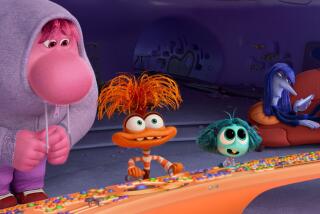MAZURSKY SHOPS FOR UPSCALE LAUGHS
- Share via
With just two weeks until the opening of his new film, “Down and Out in Beverly Hills” (opening citywide Jan. 31), director Paul Mazursky bubbles with nervous energy. Stabbing at a piece of broiled chicken in a restaurant in the Rodeo Collection, he waxes on the centerpiece of his movie.
“Beverly Hills is a place where a shirt on sale is likely to cost more than a whole suit would cost a well-heeled New Yorker. I saw a shirt the other day marked down from $550 to $360. I almost bought it--even though I would never pay that much for a shirt--because it seemed like such a good deal.”
It is no accident that in “Down and Out” the audience never sees the same set of satin sheets twice in the garish master bedroom of Dave and Barbara Whiteman, the prototypical Beverly Hills couple.
Or that the family dog, Matisse, is treated by his own personal psychiatrist and is diagnosed as suffering from a severe case of nipple anxiety.
Or that the gardener owns a condo on Maui and wears a Rolex watch to work.
This is, after all, a close-up look at the indiscreet charm of the nouveau riche as seen through the semi-jaundiced eye of director Mazursky, an unabashed, hard-core New Yorker who now lives--where else?--in the heart of Beverly Hills.
“Down and Out” is Mazursky’s ninth film and the closest he’s come to an all-out comedy. Loosely based on the 1932 Renoir film “Boudou Saved From Drowning,” it tells the story of a homeless bum (Nick Nolte) who tries to drown himself in the Whitemans’ backyard pool. (Richard Dreyfuss plays Whiteman, a multimillionaire clothes-hanger manufacturer, and Bette Midler is his wife, Barbara, who takes lunch and yoga lessons.) When Whiteman saves the bum, he also takes pity on him and invites him to come live in the family’s poolside cabana.
But just as Nolte adapts to the comforts and eccentricities of this ultra-rich life style, he also wreaks havoc on his new hosts. “This is a film about a very serious subject,” says Mazursky. “It’s about homeless people and miserably unhappy rich people. It’s about consumer consumption and it’s about people who don’t relate to each other.”
Potentially the most commercial film of Mazursky’s career (he made the enormously successful “Unmarried Woman,” as well as the enormously unsuccessful “Tempest”), “Down and Out” has a lot riding on it. It is the first movie to be released under Touchstone Films by the new management team at Walt Disney Productions. It is also the first film ever to come out of the studio with an R rating. And it marks the first major movie roles in several years for actors Dreyfuss and Midler.
It is unique in other ways as well. “Down and Out” is one of the rare adult comedies to come out of Hollywood in recent years. “We (Mazursky and writing partner Leon Capetanos) wanted to make a comedy that we laughed at, not the kind of movie where the kids are all laughing and we’re not,” says Mazursky. “We didn’t laugh at ‘Ghostbusters’ and we didn’t laugh at ‘Spies Like Us.’ That doesn’t mean they’re no good, but we wanted to make a movie we laughed at.”
The result is a film that is getting good advance word-of-mouth but one that some Disney executives worry may be too upscale for the broad market that’s needed to build a blockbuster.
But Jeff Katzenberg, chairman of the motion picture and television divisions of the studio, doesn’t worry: “People in Peoria know more about Beverly Hills than the people who live in Beverly Hills. It’s a place that has become part of our culture. It’s something everybody can identify with.” (Katzenberg speaks from experience: While at Paramount he was part of the team that developed and supervised the megahit “Beverly Hills Cop.”)
“I’m not worried about the big cities,” says Mazursky. “It’s the small towns you wonder about. Will they get it there? But listen, the farmer in Peoria today probably has a satellite dish. He wakes up to ‘Good Morning America’ and goes to sleep to Dr. Ruth. He’s probably hipper than I am.”
Mazursky is standing on Rodeo Drive in front of Carrita, a tres -expensive clothing boutique. The director is hamming it up for a photographer when a woman pushing a baby carriage strolls by. “Look, a Beverly Hills baby,” Mazursky says playfully. But the woman stares blankly ahead and quickly pushes her baby around Mazursky without so much as a smile. “See that? There’s no laugh,” says Mazursky sadly. “The money takes it away.”
Mazursky’s challenge in the making of this film was to make the very serious subject of money funny. “I decided I really wanted to go at it; I wanted to make fun of it,” says Mazursky, sporting a plastic watch and an expensive Versace wool blazer given to him for a GQ magazine spread. “I mean, here I am in a town where the women wear fur coats not because it’s cold but because it’s the season and where I go to a dinner party and the host has his guru at the dinner table” (something that happened to him and which he used in the film).
Because of its comparatively easy subject matter, one wonders if Mazursky made “Down and Out” to show the studios that he can still turn out the commercial movie, that he is still “bankable.”
“For me the point was not to prove to the studios, OK, I can make a comedy, but to find my next movie. If you’re worried about the studios, you do not make ‘Moscow on the Hudson,’ because the first 20 minutes of the movie is in subtitles and there are 80 million people in this country who can’t read.”
The irony is that Mazursky is part of the crowd he is parodying in “Down and Out.”
“My crowd of friends is not the people in this movie, but I’m not taking myself out of the pack,” he says. “There is a part of me that wants a bigger TV set or a better car (he came to the interview in a gray Honda Accord but admits that he owns a Mercedes), but I think I can handle it. There is an awareness that dilutes it all. I think I’m still healthy.”
Mazursky, 55, has certainly come a long way. He grew up poor in Flatbush, a rough section of Brooklyn, N.Y., where his father bundled newspapers for a living.
He began his career as an actor. His first role was in then first-time director Stanley Kubrick’s “Fear and Desire” (1953). (That’s also Mazursky playing the pushy accountant Sidney Waxman in “Down and Out.”) Before writing and directing movies, he wrote for the Danny Kaye show, played as a stand-up comic in clubs like the Village Vanguard in New York and the Hungry i in San Francisco.
“Beverly Hills is the only place I know where you go into a clothing store and you say, ‘I want a shirt to wear with this black suit’ and the salesman brings you a yellow shirt and you say to the guy, ‘I don’t want yellow; it’s too far out.’ And he says to you, ‘Perhaps it’s just too far out for you. You could wear it; you could make a statement, but you have no courage at all.’ And you walk out of the store and he has humiliated you.”
As he has in most of his other films, Mazursky uses humor in “Down and Out” to communicate a message. “I am not on a soap box and, all things considered, I would rather be rich than poor,” he says. “But all things being equal, money does not buy happiness. It buys a more comfortable journey or a better dress, but the complications are profound.”
Standing on Rodeo Drive, Mazursky spots an old friend. Robert Solo, his former agent, now a producer, comes by to say hello. “So when do you open?” Solo asks. The two exchange pleasantries and, as Solo walks away, Mazursky feigns anger. “You see that? They don’t ask, ‘How are you?’ or ‘How’s your wife?’ or ‘Do you have cancer?’ or ‘Are you alive?’ They ask, ‘When do you open?’ ”
But as Solo walks away, a smile creases Mazursky’s face. After all, they’re still asking.
More to Read
Only good movies
Get the Indie Focus newsletter, Mark Olsen's weekly guide to the world of cinema.
You may occasionally receive promotional content from the Los Angeles Times.










